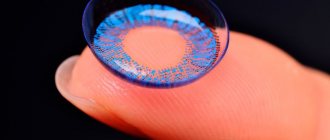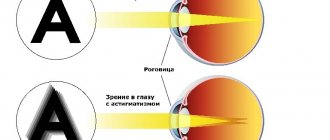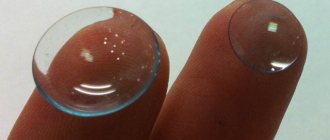Many human diseases cannot be completely cured, as a result of which the patient constantly feels a feeling of discomfort and an unfulfilling life. The situation is similar in the case of such an eye problem as astigmatism. The patient needs some time and patience to get used to optical glasses. However, the use of contact lenses to treat astigmatism not only saves a person from constantly using glasses, but also allows for proper vision correction.
Various disease defects
Our eye refracts light fluctuatingly. This is explained by its anatomical structure, physiology and functions of refractive media. Normal physiological astigmatism is considered to be a deviation from the norm of up to 0.34 diopters. This condition does not impair vision, does not tire the eyes, does not cause headaches, double vision or asthenopic symptoms. Each of us can have this astigmatism.
A pathological defect, on the contrary, causes a lot of discomfort and is unfavorable for children. If it is not treated in time, the baby may develop strabismus or the so-called “lazy eye,” which cannot be corrected.
How can astigmatism be diagnosed today?
For a high-quality diagnosis of astigmatism, we need two conditions. The first is high-tech, high-precision equipment and the second condition is highly qualified personnel. In the SAGA-OPTIKA salon-shop we can detect even small degrees of astigmatism and by correcting this astigmatism we can significantly improve the quality of vision, and thereby we can improve the patient’s quality of life
In our SAGA-OPTIKA showroom, we have the necessary equipment - an autorefkeratometer and cross-cylinders. Popularly, vision diagnostics using an autorefkeratometer is often called computer diagnostics, and it is this that allows one to very quickly identify the presence of astigmatism in a patient. At the same time, our highly qualified optometrists do not rely entirely on the results that the autorefkeratometer produces. They are required to carry out an additional subjective selection using a set of trial spectacle lenses. Thus, the combination of computer diagnostics and professional subjective selection allows the specialists of the SAGA-OPTIKA store to carry out high-quality selection of glasses, providing our clients with correct vision correction while maintaining maximum comfort.
Causes of pathology
There are two types of astigmatism - lenticular and corneal. The first occurs due to a defective shape of the lens, its partial or complete ectopia. The reason for the second pathology lies in the irregular shape of the cornea, which does not allow the rays to be focused at a certain point on the retina. In this case, a person sees blurry images of objects.
If the refractive power of the cornea is about 43 diopters, then the lens has only 19 diopters. Since the cornea is more important in the refraction (refraction) of rays, distortion of its configuration usually causes astigmatism.
Common causes of the disease are:
- Heavy heredity . A congenital disease is usually formed at the gene level if parents have the same problem. Astigmatism, caused by a defect in the genetic code, is diagnosed in early childhood.
- Inflammation of the eyes . Most often, curvature of the cornea occurs due to keratitis, which disrupts the structure of the membrane, causing deformations and opacities. This impairs the refractive power of the eyes.
- Injuries . Superficial and penetrating injuries to the apple often cause dislocation (subluxation) of the lens, scratches and ruptures of the cornea. Scars form on the shell, changing its shape. A person develops unilateral, usually irregular, astigmatism.
- Degeneration and dystrophy of the cornea . Such diseases distort the standard shape of the sclera. In its normal form it should be a clear hemisphere, but with defects (keratoconus, keratoglobus, etc.) it becomes curved or uneven.
- Surgical interventions . Treatment accompanied by an incision of the cornea often causes deformation of the latter. The reason for this is incorrectly applied, frayed sutures, and their removal ahead of time.
Unique long focus lens
Our clinic also successfully uses the extended (extended) focus lens TECNIS SYMFONY. According to its characteristics, this artificial lens is close to trifocal lenses, but it has its own characteristics. It has one focus, just like monofocal lenses. But due to the innovative features of this focus, it provides excellent vision both at distance and at medium distances. A person no longer needs glasses for distance or medium distance. Neither for working on a computer, nor for driving a car.
Color rendition: muted or bright?
Each representative of the “star trio” has its own design features, which the ophthalmologist takes into account when recommending one or another model to the patient. This applies, for example, to color rendering. Some patients prefer lenses with a yellow filter. These lenses include ACRYSOF IQ PANOPTIX . The yellow filter provides color rendering that matches the own lens of a middle-aged and elderly person. The colors are perceived a little “muted”, not so bright. This is exactly how the vast majority of people after fifty years see it.
The ZEISS AT LISA TRI lens does not have a yellow filter. It is distinguished by a brighter, “richer” color rendition, corresponding to the vision of young people. A significant portion of “golden age” patients choose these lenses because... they provide the “second youth” of the eyes to the greatest extent. A seventy-five-year-old patient begins to see as well as a twenty-five-year-old!
Types of astigmatism
Taking into account the area of concentration of the optical focus, a myopic, farsighted (hyperopic) or mixed defect is distinguished. In the first case, the rays are localized in front of the retina, in the second - vice versa. The third type of pathology combines ailments in the form of both farsightedness and myopia. Let's consider these cases in more detail.
- Simple myopic , when the refraction of rays in one of the main meridians (usually horizontal) is standard, but in the other it will be increased. Excessive refraction causes some rays to focus in front of the retina, blurring the image of objects.
- For myopic astigmatism in its advanced form, increased refraction of the meridians, which is manifested in different ways, is especially common. The visible image is concentrated in front of the retina, and the patient experiences blurred shapes and poor distance accommodation.
- Simple hypermetropic syndrome is manifested by normal emmetropia of one meridian and weakening of the process in the second. Because of this, some of the incoming rays are localized on the retina, and the rest behind it.
- A complex farsighted case is characterized by weak refraction in all meridians, which manifests itself differently. Therefore, a distorted image of surrounding objects appears behind the retina of the diseased eye.
- With a mixed illness, one meridian refracts light in excess, and the other, vice versa. As a result, a group of rays falls in front of the retina, while others penetrate behind it. This defect is characterized by noticeable blurred vision.
The irregular type of astigmatism is characterized not only by the difference in the curvature of the two main meridians, but also by the dissimilarity in the refractive power in each of them. The reason is the uneven shape of the cornea. Such a defect cannot be corrected externally - neither with glasses nor contact optics.
Lenses for astigmatism. What are the benefits?
Treatment of astigmatism with contact lenses has many advantages, because today toric lenses are made of silicone hydrogel and hydrogel material, which is perfectly perceived by the cornea. Plus, each patient, depending on his physiological characteristics and lifestyle, can choose the wearing mode that is convenient for him. These lenses also have a special locking mechanism that allows you to hold the lenses in one position. They are resistant to drying out, have excellent oxygen permeability, and the adaptation period lasts much less than with glasses. Toric lenses provide a high degree of clarity of vision and fit tightly to the eyes, forming one optical system with them.
Benefits of contact lenses for astigmatism correction:
- minimal viewing restriction and high image clarity;
- optimal conditions for lateral vision;
- minimum prismatic effect;
- perfectly moisturizes the eyes;
- allow the maximum amount of oxygen to pass through;
- increase visual acuity.
Types of refractive errors
An astigmatic eye has two main mutually perpendicular meridians. One refracts the light beam more strongly, the second - weaker. The location of the eye meridians determines the variant of the existing astigmatism, namely:
- The direct type (stronger refraction in the vertical meridian) is recorded most often.
- Reverse ( increased refraction in the horizontal meridian) – is observed infrequently and causes a lot of discomfort to the patient.
- A defect with oblique axes is characterized by an inclined arrangement of the main meridians.
What should patients with myopia do?
High myopia itself (we have many such patients!), fortunately, is not an obstacle either to trifocal lenses or to lenses with a prolonged (extended) focus. But this visual pathology is another reason for the most thorough, detailed examination of the patient.
We must make sure that myopia does not lead to complications on the retina. It is these complications, unfortunately, that can become contraindications for the implantation of premium lenses in question.
Degrees of astigmatism
This indicator is defined as the difference in the refractive powers of the main meridians and is expressed in diopters. The higher the degree of pathology, the worse the vision. There is the following gradation of astigmatism:
- High (from 6 diopters and above);
- Medium (within 3-6 diopters);
- Weak (less than 3 diopters).
A visual defect that does not reach 0.5 diopters occurs without significant discomfort and does not need correction. It is necessary to use optics in cases where the disease affects the ability to work or causes inconvenience to the person.
Symptoms of pathology
It is known that physiological astigmatism is not clinically manifested, and we do not notice it. This defect is harmless, does not cause complications, and does not need correction. Typically, disturbing symptoms are typical for pathologies of various types.
Main signs of the disease:
- Fuzzy and distorted visualization of objects;
- Decreased visual acuity;
- Acquired habit of squinting or pulling the eyelids to the sides;
- Visual discomfort (asthenopia).
If there are difficulties with accommodation, a person becomes fatigued. Looking around him, he has to strain his eye muscles to bring the focus closer to the retina. At the same time, discomfort, painful sensations in the eyes and frequent headaches are felt.
In the future, such people may develop strabismus, which is often characteristic of children after 2-4 years of age. This condition is dangerous with irreversible consequences and can cause amblyopia (“lazy eye”) as a deviation in the functioning of the visual organ.
What are the contraindications?
Ophthalmologists distinguish between types of contraindications: medical and social. Medical contraindications include the consequences of injuries to the organ of vision, serious pathologies of the retina, optic nerve, and cornea. Only a preliminary medical examination can determine whether these contraindications exist in each specific case.
Social contraindications mainly include mental disorders, as well as features of the patient’s lifestyle and work. In some cases, it is advisable for people with intense visual difficulty to opt for monofocal lenses. This may apply to pilots, vehicle drivers, train drivers, watchmakers, astronomers, etc. However, there are no uniform rules here either. Each case is considered individually.
Diagnostics
The presence of a refractive defect is determined by the patient’s typical complaints. The diagnostic plan usually includes vision and refraction tests, biomicroscopy, skiascopy and measurement of pressure inside the eyes.
The most inexpensive and accurate method is skiascopy. In 5-10 minutes you can determine emmetropia in all meridians, establish all indicators and signs of astigmatism. Modern refractometry is used for the same purpose.
When diagnosing a corneal defect, ophthalmometry and electronic keratotopography are most often used. A standard shell should look like a perfectly flat sphere. In patients with refractive errors, these methods can measure the curvature of the cornea and imperfections on its surface.
Artificial lenses for both eyes
In order for the artificial lenses we are talking about to provide the patient with good vision, they must be implanted in both eyes. Even if in some cases a cataract has formed in only one eye, there is a need to replace both lenses.
About light sources on a dark background
One feature of trifocal lenses and a lens with a prolonged focus - with all their numerous and undeniable advantages! – may initially cause discomfort in some patients. When a person encounters bright light sources against a dark background, for example, night lamps, small optical interference may occur in the form of circles (halos) around the light source. As a rule, our brain gets used to this feature within a few months, and people stop noticing it.
Vision correction
To correct simple types of myopia and farsightedness, cylindrical lenses are used that refract the light beam perpendicular to the axis of the cylinder. Complex and mixed vision defects require a combination of two lenses - spherical and cylindrical.
Glasses and contact optics cannot solve the problem; they only correct the refraction of the beam. Therefore, along with correction, you need to find the source of the pathology in order to eliminate it to the best of your ability. This is how the doctor stops the further development of the disease.
For astigmatists, optical lenses are more comfortable and more effective than glasses. It is important to give them the correct position using the latest techniques (ballast, periballast, etc.)
Happy relief from farsightedness
Patients with farsightedness are probably the happiest and most grateful people who receive trifocal lenses and extended focus lenses in our clinic. It is these patients who are forced to use several pairs of glasses and constantly change them. Therefore, getting rid of optical correction devices thanks to a modern artificial lens is a reasonable and logical solution.
Trifocal lens for patients with astigmatism
For patients with astigmatism, a special (toric) modification of the ACRYSOF IQ PANOPTIX lens is intended, which is called toric . Carrying out these operations requires special skill of the surgeon because he needs to find the axis of astigmatism location and determine the strength of astigmatism. In simple terms, the artificial lens is implanted at a certain angle, which must first be calculated.
Laser therapy
For irregular astigmatism, these procedures are prescribed for those who do not want to wear optics. Laser correction is carried out at the request of the patient and is the most popular method of surgical treatment of vision defects.
Contraindications for refractive surgery:
- Serious retinal damage;
- Decompensated diabetes mellitus;
- Eye inflammation, glaucoma or cataracts;
- Pregnancy and breastfeeding.
Laser therapy is very effective for patients with irregular astigmatism that cannot be corrected optically. The method will eliminate corneal defects and restore its standard configuration. After the operation, people begin to clearly see surrounding objects.
How to care for contact lenses?
A number of recommendations for caring for contact lenses will help you avoid some possible complications.
- If the patient wears lenses that must be replaced every three months, he should wipe them after each removal. This is done in order to remove deposits and microorganisms that tend to accumulate during constant wear.
- Contact lenses should be stored in special disinfectant solutions.
- It is strictly forbidden to rinse contact lenses and containers with ordinary running water, since it contains a large number of microorganisms that can impair vision.
- It is not recommended to wear lenses longer than prescribed.
Every patient should remember that correction of astigmatism with contact lenses should be carried out by a competent ophthalmologist.











